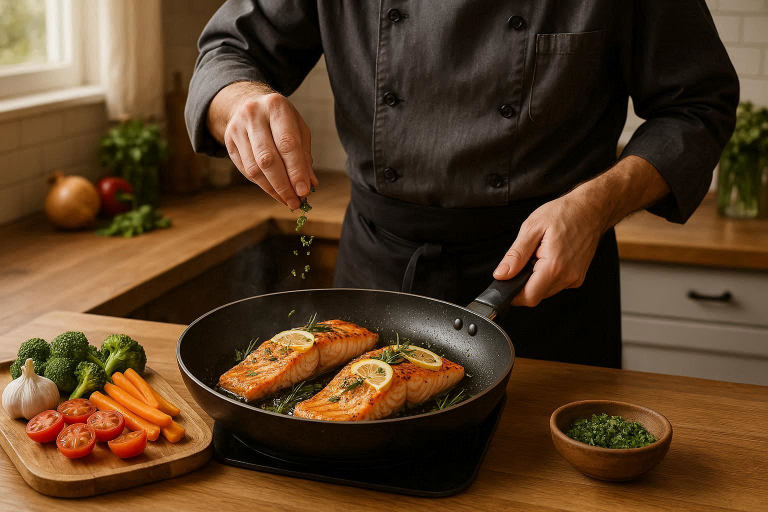Salmon is a versatile and healthy fish that’s packed with flavor, and cooking it in a pan is one of the easiest and most rewarding methods to achieve a juicy, crispy-skinned fillet in no time. Whether you’re preparing dinner for your family on a weeknight or cooking a special meal for guests, pan-searing salmon is a quick and simple solution that delivers delicious results every time.
In this guide, we’ll walk you through a step-by-step process for cooking perfect salmon in a pan, including tips, tricks, and flavor suggestions. Let’s dive into how you can make the best pan-seared salmon at home!
How do you cook salmon in a frying pan?
Cooking salmon in a frying pan is quick and easy, and it results in a crispy skin and tender flesh. Here’s how to do it:
-
Prepare the salmon: Start by patting the salmon dry with paper towels to remove excess moisture. This helps it crisp up in the pan. Season both sides with salt and pepper. You can also add lemon zest, garlic powder, or herbs like dill for extra flavor.
-
Heat the pan: Use a nonstick or cast iron skillet. Heat the pan over medium-high heat and add about 1-2 tablespoons of oil. Olive oil, vegetable oil, or avocado oil work well for this method.
-
Cook the salmon: Once the pan is hot, add the salmon skin-side down. Cook for about 4-5 minutes without moving it, allowing the skin to become crispy. Then, flip the salmon over and cook for another 3-4 minutes, depending on the thickness of the fillet. For medium-rare salmon, aim for an internal temperature of 125°F (52°C).
-
Rest: Once cooked, remove the salmon from the pan and let it rest for a couple of minutes before serving.
Pan-fried salmon is quick, flavorful, and perfect for a healthy meal in just a few minutes!
Is it better to pan fry salmon with butter or oil?
Why Pan-Seared Salmon is the Best Choice
Quick and Easy Cooking Method
Pan-searing salmon is one of the fastest ways to cook this flavorful fish, making it ideal for busy weeknights or when you’re short on time. Unlike grilling or baking, which can take longer and require extra preparation, pan-searing allows you to cook your salmon in just a few minutes. Whether you’re using a cast-iron skillet or a non-stick pan, this method ensures your salmon is cooked evenly and quickly, preserving its natural juices and flavor.
Achieving a Delicious, Crispy Skin
One of the biggest reasons people love pan-searing salmon is the ability to get that perfect crispy skin. When you place the salmon skin-side down in a hot pan, the skin crisps up beautifully, adding a wonderful texture and flavor to your dish. This crispy crust comes from the Maillard reaction (the browning of proteins), which Guide to Mastering Everyday Cooking occurs when the fish meets the heat of the pan, intensifying the taste and giving it that irresistible golden-brown finish.
Retaining Juiciness and Flakiness
Cooking salmon in a pan helps lock in moisture, ensuring that your fillet remains tender and juicy. Unlike grilling, where the heat can dry out the fish, pan-searing allows you to control the heat and cooking time precisely. With just a few minutes on each side, you’ll have a perfectly flaky, succulent piece of salmon.
Tools and Ingredients You Need to Cook Salmon in a Pan
Essential Tools
- Non-stick skillet or cast-iron pan – A non-stick pan is the easiest to use for beginners, while a cast-iron skillet provides excellent heat retention, allowing for a crispy crust.
- Fish spatula or regular spatula – A fish spatula is thin and flexible, making it perfect for flipping delicate fish without breaking it apart.
- Tongs – Tongs are useful for carefully handling the salmon, especially if it’s skin-on.
Salmon Selection
When choosing salmon, you have two options: wild-caught or farmed. Wild-caught salmon tends to have a richer, more robust flavor and a firmer texture, while farmed salmon can be milder and fattier. Both are good choices for pan-searing, so it’s really up to your personal preference.
As for the fillets, skin-on salmon is recommended for pan-searing, as the skin adds flavor and helps keep the fillet intact while cooking. If you prefer skinless salmon, no problem—it will cook similarly, but the texture may be slightly different.
Seasoning and Flavoring Essentials
The beauty of salmon lies in its natural flavor, so the seasoning should complement, not overpower. Here’s what you’ll need for a basic but flavorful salmon fillet:
- Salt and pepper – The basic essentials.
- Lemon – A squeeze of fresh lemon adds brightness and balance.
Optional extras for a flavor boost include:
- Garlic – Minced garlic adds a savory depth to the salmon.
- Dill or thyme – Fresh herbs enhance the flavor.
- Paprika – For a slight smoky kick.
- Butter and olive oil – For basting and adding richness.
Step-by-Step Guide: How to Cook Salmon in a Pan
Step 1 – Prepare the Salmon
Before you start cooking, thaw your salmon fillets if they’re frozen. The best way to do this is to leave them in the refrigerator for several hours, or you can defrost them quickly in cold water. Once thawed, pat the salmon dry with a paper towel to remove excess moisture. This is crucial for achieving that crispy skin!
Now, season your fillets evenly with salt and pepper. You can also add some garlic powder, paprika, or fresh herbs if desired. Be sure to season both sides of the fish for the best flavor.
Step 2 – Heat the Pan
Preheat your non-stick skillet or cast-iron pan over medium-high heat for a few minutes. The pan should be hot enough to create a crispy crust on the salmon but not so hot that it burns the fish. Add a tablespoon of oil (olive oil or avocado oil works well), or use a mix of butter and oil for extra richness. Allow the oil to heat up and shimmer in the pan before adding the salmon.
Step 3 – Cooking the Salmon
Place the salmon fillets skin-side down in the pan. Be sure to lay the fillets away from you to avoid any hot oil splattering. You should hear a satisfying sizzle once the fish hits the pan. Let the salmon cook undisturbed for 3-4 minutes on the first side. This allows the skin to crisp up and the fish to cook through halfway.
After 3-4 minutes, flip the salmon gently with a fish spatula or tongs. Cook the other side for another 2-3 minutes, depending on the thickness of your fillet. The goal is to have a nice golden-brown crust on both sides while keeping the center tender and juicy.
Step 4 – Adding Flavor Boosts
During the last minute of cooking, you can baste the salmon with butter and fresh herbs like rosemary or thyme. Add a couple of tablespoons of butter to the pan and spoon it over the fish to enhance the flavor. You can also squeeze lemon juice over the salmon to give it a fresh, zesty finish.
Step 5 – Check for Doneness
To check if your salmon is done, use the finger test—gently press down on the top of the fillet. If it flakes easily, it’s ready! Alternatively, use a meat thermometer. For medium-rare salmon, the internal temperature should be between 120-125°F. For a more well-done fillet, cook it until it reaches 145°F.
Tips for Perfect Pan-Seared Salmon
Skin-On vs. Skinless Salmon
For the crispiest result, always cook skin-on salmon. The skin provides a protective layer that helps retain moisture and gives your fish a lovely crispy texture. If you’re using skinless fillets, they will still cook well, but you may need to adjust your technique to avoid overcooking.
Avoiding Overcooking
The biggest mistake people make when cooking salmon is overcooking it. Salmon cooks very quickly, and a little goes a long way. The key is to cook it for just the right amount of time. If you overcook it, the salmon can become dry and lose its rich flavor.
Adjusting Cooking Times Based on Thickness
Thicker fillets will require a little more time in the pan, while thinner fillets cook faster. Adjust your heat accordingly and keep an eye on the salmon to avoid overcooking. You can also lower the heat slightly if you’re worried about burning the crust while the inside cooks through.
Experimenting with Different Flavors
Feel free to get creative with the seasoning! Paprika, cumin, curry powder, or even a soy sauce glaze can elevate the flavor profile of your salmon. You can also top it with something fresh like avocado slices or mango salsa to add a refreshing contrast to the richness of the fish.
Serving Suggestions for Pan-Seared Salmon
Side Dishes That Pair Perfectly with Salmon
- Vegetables: Pair your salmon with sides like roasted asparagus, sautéed spinach, or steamed broccoli. These vegetables complement the rich, savoury flavours of the fish.
- Grains: Quinoa, rice pilaf, or couscous are all excellent choices to round out your meal and add some texture.
Fresh and Zesty Salad Pairings
A light arugula salad with avocado, citrus slices, and a lemon vinaigrette is a perfect contrast to the rich, oily salmon. The freshness of the salad balances out the richness of the fish and brightens the overall dish.
Wine Pairings
Salmon pairs beautifully with white wines like Chardonnay, Sauvignon Blanc, or even a lighter Pinot Noir. These wines complement the delicate flavor of the salmon and bring out its subtle richness.
Common Mistakes to Avoid When Cooking Salmon in a Pan
Not Letting the Pan Heat Enough
If your pan isn’t hot enough, your salmon will cook unevenly, and the skin won’t get crispy. Always preheat your pan thoroughly to ensure a nice sear.
Overcrowding the Pan
Cooking too many fillets at once can cause the temperature of the pan to drop, resulting in steamed salmon instead of crispy salmon. Cook in batches if necessary, leaving plenty of room between fillets.
Not Checking for Doneness
Salmon cooks quickly, so it’s important to check for doneness early. Use a thermometer or the finger test to avoid overcooking.
FAQ=
Q: Can I use frozen salmon for pan-searing?
Yes, you can! Just be sure to thaw the salmon first and pat it dry to avoid excess moisture.
Q: How do I know when salmon is perfectly cooked?
Salmon should flake easily with a fork and have an internal temperature of 120-125°F for medium-rare. For well-done, aim for 145°F.
Q: What oil is best for pan-searing salmon?
Olive oil, avocado oil, or a mix of butter and oil work great for pan-searing. Avoid oils with low smoking points, like butter alone, unless you add it at the end.
Q: How do I get crispy skin on salmon?
Make sure your salmon is dry before cooking and cook it skin-side down in a hot, oiled pan.
Q: Can I cook salmon in a non-stick pan?
Yes! A non-stick pan is perfect for easy flipping and ensuring your salmon doesn’t stick.
Conclusion
Pan-searing salmon is an easy, delicious, and foolproof way to cook this flavorful fish to perfection. By following the simple steps outlined in this guide, you can achieve crispy skin, juicy meat, and a meal that’s sure to impress. Don’t be afraid to experiment with different flavours and side dishes to personalise your salmon!
Now, it’s your turn to cook up a perfect pan-seared salmon dinner. Share your experiences or questions in the comments below—we’d love to hear how your salmon turns out!

